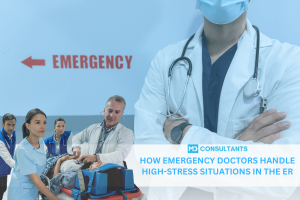Workplace burnout is becoming an increasingly alarming issue across industries, but especially in high-demand sectors like healthcare. Defined by chronic workplace stress that hasn’t been successfully managed, burnout can lead to exhaustion, reduced professional efficacy, and a sense of detachment. In the fast-paced world of healthcare, where long hours and emotional strain are common, burnout isn’t just a personal concern—it’s a systemic issue that affects team morale, patient care, and even organizational performance.
The Scope of the Burnout Crisis
Recent surveys reveal that more than 50% of professionals report feeling burned out, with healthcare workers topping the list. The pandemic only magnified this problem. Doctors, nurses, and support staff were hailed as heroes, but behind the scenes, many were struggling to keep up with relentless demands, under-resourced teams, and an ever-changing set of expectations.
Burnout doesn’t just impact the individual; it seeps into every aspect of the workplace. When employees are chronically stressed, their engagement, productivity, and creativity plummet. For healthcare providers, this can mean medical errors, increased absenteeism, and high turnover rates—all costly consequences that can disrupt service delivery.
Understanding the Causes
Before we can solve the problem, we need to understand it. Some of the leading causes of workplace burnout in healthcare include:
- Unmanageable workloads: The healthcare industry often requires professionals to work long hours with little rest, leading to physical and emotional fatigue.
- Lack of autonomy: Employees who feel they have no control over their work or environment are more likely to feel helpless and burned out.
- Insufficient support: Whether it’s a lack of managerial backing or inadequate mental health resources, feeling unsupported can deepen stress.
- Poor organizational culture: A toxic or unsupportive workplace culture exacerbates burnout.
Signs to Watch For
Burnout doesn’t always announce itself loudly. It can sneak up through subtle behavioral and emotional shifts:
- Emotional exhaustion
- Detachment from work or cynicism
- Decreased performance
- Increased absenteeism
- Difficulty concentrating
- Physical symptoms like headaches, sleep issues, or GI disturbances
Healthcare leaders must be trained to recognize these signs early. By addressing them proactively, they can prevent minor issues from escalating into a full-blown burnout crisis.
What Employers Can Do
Thankfully, there are actionable strategies that healthcare organizations and leaders can implement to combat burnout.
1. Build a Supportive Culture
Organizations need to foster a workplace environment where employees feel heard, respected, and supported. This includes encouraging open communication, valuing feedback, and creating peer support networks. A healthy work culture promotes emotional safety, which is vital in high-pressure environments.
For help implementing cultural shifts that prioritize mental wellness, MD Consulting offers customized organizational health and wellness solutions to suit your clinic or hospital’s unique needs.
2. Rethink Workloads and Staffing
Overloaded teams are more vulnerable to burnout. It’s crucial to audit workloads, ensure fair distribution of tasks, and hire additional staff when needed. Automating routine tasks and utilizing telehealth solutions where possible can also reduce pressure on in-person teams.
Our health services delivery experts can help you identify inefficiencies in care delivery and suggest innovative models that reduce provider strain without sacrificing quality.
3. Prioritize Mental Health Resources
Mental health must be treated with the same seriousness as physical health. Offering free or subsidized counseling, mental health days, and regular wellness check-ins can go a long way. Peer support groups, especially those facilitated by a trained coach or counselor, can also provide valuable emotional relief.
4. Offer Professional Development
Sometimes, burnout stems from stagnation. Give employees opportunities to grow through mentorship, certifications, or career path development. Investing in their future shows you value them not just as workers but as professionals.
For those starting new practices or considering healthcare entrepreneurship, our healthcare startup consulting services can provide guidance, mentorship, and strategic planning support.
5. Implement Flexible Schedules
Where feasible, offer flexible shifts, job sharing, or remote work. Even small changes like rotating weekends off or longer breaks between shifts can reduce fatigue and improve morale.
What Employees Can Do
While systemic changes are crucial, individual coping strategies also matter. Here are a few things employees can do to protect their well-being:
1. Set Boundaries
Say “no” when necessary. Protect your off-hours and prioritize personal time. This isn’t selfish—it’s essential for recovery.
2. Practice Self-Care
Exercise, sleep, and good nutrition are foundational to resilience. Make time for hobbies and disconnect from work during downtime.
3. Seek Help
Don’t hesitate to reach out for professional support. Therapy, coaching, or even a supportive colleague can make a significant difference.
4. Stay Connected
Social support is one of the most powerful tools against burnout. Regular check-ins with peers or mentors can help process emotions and share solutions.
5. Reflect and Realign
Sometimes, burnout signals a need for change. Reflect on what you value in your work. Are you doing something meaningful? If not, it may be time to pivot.
The Role of Leadership
Leaders in healthcare carry a tremendous responsibility—not only for patient outcomes but for the health of their teams. Leadership styles can significantly influence burnout rates. Empathetic, responsive leaders who check in regularly and model work-life balance can set the tone for a more supportive culture.
Training leaders to manage stress, communicate effectively, and support their teams is key to sustainable change. At MD Consulting, we help healthcare organizations elevate their leadership through targeted healthcare consulting strategies.
Conclusion: Burnout Isn’t Inevitable
Burnout may be on the rise, but it’s not inevitable. It is a symptom of a broken system, not a personal failure. With intentional strategies, systemic support, and individual action, healthcare organizations can create resilient, healthy workplaces where professionals thrive.
At MD Consultants, our mission is to help healthcare organizations innovate, grow, and support the well-being of every team member. Whether you need help launching a new clinic, improving care delivery, or transforming your organizational culture, we are here to help.
Visit MD Consultants to learn more about our organizational health and wellness, healthcare startup consulting, and health services delivery programs designed to keep your team performing at their best—without burning out.
Together, we can beat workplace burnout.
Related Reading: Combating Burnout: An 8-Step Guide for Medical Professionals






